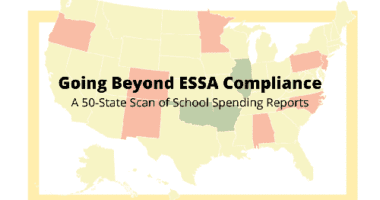Closing Long-Standing Opportunity and Achievement Gaps: Testing and Transparency Are Critical, But Schools Must Be Accountable for Doing Their Part
It’s a common refrain on Capitol Hill that the new education law Congress is working on right now should get the federal government out of micromanaging American public schools, letting states and communities decide how to educate their children.
 We agree that the federal government shouldn’t micromanage public schools and that too much of that has been going on in recent years. We also agree that the current Elementary and Secondary Education Act has a lot of built-in problems, including an overly rigid approach to school accountability, where both goals and consequences are dictated from Washington.
We agree that the federal government shouldn’t micromanage public schools and that too much of that has been going on in recent years. We also agree that the current Elementary and Secondary Education Act has a lot of built-in problems, including an overly rigid approach to school accountability, where both goals and consequences are dictated from Washington.
But what we can’t agree to is the idea that Congress should ask nothing of schools in return for the $15 billion in taxpayer dollars it directs to them in Title I funds every year. And we can’t agree to the idea that, left to their own devices and completely freed of federal oversight, schools and districts in every state will rush to do everything in their power to educate all of their children well.
My colleagues and I spend a lot of time in school districts around the country. And we spend a lot of time analyzing the reams of data produced by schools.
Some of this gives us great inspiration, for we often see dedicated educators working very hard to help all of their students succeed and in turn, producing stunning results. There are schools like Bethune Elementary, a traditional public school in New Orleans, where principal Mary Haynes-Smith and her teachers get nearly every one of their children — almost all of whom are low-income African Americans — to state expectations. And districts like Charlotte and Houston where relentless focus has paid off in results for students considerably better than in districts serving the same kinds of children.
But sadly, what the data tell us is that these schools and districts are still isolated and unusual. Inequality, in other words, is by no means simply a historical artifact.
There remain school districts in America where even the highest achieving, black students are half as likely to be placed in algebra as their similar-achieving, white and Asian counterparts. There remain school districts in America where inadequately trained educators assume that, just because their mastery of our common language is inadequate, English learners must need to be in remedial math courses as well. And there are plenty of school districts in America where boys of color are disciplined far more harshly than white boys who commit the same infractions.
While many things have gotten better since Brown v. Board of Education, when researchers examine the patterns across America as a whole, the remaining inequalities are staggering. We spend less in the school districts with the most children of color than we do in the districts with the fewest — about $2,000 less per student, in fact. We expect less from them, often giving them A’s for work that would earn a C in the suburbs. We often program them into watered-down courses. And we assign them disproportionately to our least experienced, least educated, and least effective teachers.
So while children from privileged homes may not need the federal government to look out for them, these children still do. That doesn’t mean micromanaging, but it does mean providing extra resources and insisting on progress for all groups of students, in return.










